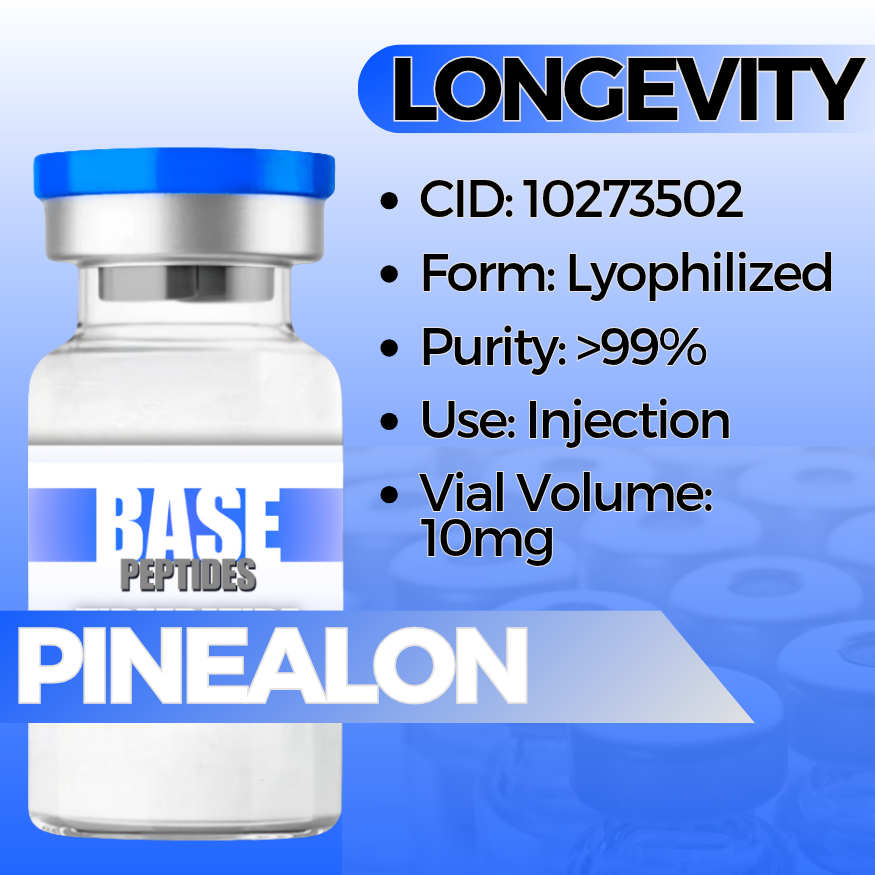Pinealon
Pinealon
Base Peptides are intended for licensed medical professionals and experienced researchers. Reconstitution required. Dosing and use instructions are not provided.
Couldn't load pickup availability
Pinealon (EDR) — Glu-Asp-Arg Tripeptide • Injectable Research Grade
Pinealon, also known as the EDR peptide, is a synthetic tripeptide (Glu-Asp-Arg) explored for neuroprotective and cell-stress biology. Studies in cells and animal models report modulation of oxidative stress markers, neuronal morphology, and gene-expression programs relevant to mitochondrial function and apoptosis.
- Synonyms: EDR peptide; H-Glu-Asp-Arg-OH
- Sequence: Glu-Asp-Arg (EDR)
- CAS No.: 175175-23-2
- PubChem CID: 10273502
- Formula / MW (typ.): C15H26N6O8 • ~418.4 g·mol⁻¹
- Class: Ultrashort peptide bioregulator (research)
- Redox & stress response: Designs show reduced ROS accumulation and improved cell viability under oxidative stress.
- Neuronal structure: Reports of preserved dendritic spines and signaling linked to synaptic maintenance in disease models.
- Gene programs: Transcriptomic work suggests effects on oxidative phosphorylation, apoptosis regulation, and cytoskeletal maintenance.
- Probe neuroprotection and cellular resilience during hypoxia, oxidative stress, or developmental insult models.
- Interrogate mitochondrial and apoptosis pathways via peptide-driven gene-expression changes.
- Compare ultrashort peptides (e.g., Epitalon AEDG) for specificity of neural vs systemic effects.
Key Study Themes — What Was Tested, What Changed, Why It Matters
Oxidative Stress & Cell Viability
- What was tested: Neuronal and immune cell models exposed to pro-oxidant stimuli ± Pinealon.
- What changed: Lower ROS accumulation and higher viability vs. stress controls in a dose-dependent fashion.
- Why it matters: Establishes EDR as a tool compound for redox biology and survival signaling screens.
Neurodevelopmental & Behavioral Readouts
- What was tested: Rodent developmental models (e.g., prenatal ethanol exposure) with cognitive endpoints.
- What changed: Improved offspring cognitive performance and neuronal morphology in select paradigms.
- Why it matters: Positions Pinealon for studies of synaptic plasticity and learning under stressors.
Gene-Expression / Mitochondrial Programs
- What was tested: In vitro transcriptomics after EDR exposure.
- What changed: Upregulation of OXPHOS related genes and regulators of apoptosis/cytoskeleton (model-dependent).
- Why it matters: Suggests a mechanistic bridge between redox status and structural maintenance.
Potential Research Applications
Neuroprotection & Plasticity
- Hypoxia/ischemia, excitotoxicity, neurodegeneration models; dendritic spine analyses.
Mitochondrial & Redox Biology
- ROS/RNS panels, antioxidant defenses, OXPHOS gene sets, apoptosis markers.
Developmental Stress Models
- Prenatal toxin exposure, behavior tasks, synaptic maturation readouts.
Synergistic / Comparator Peptides
Epitalon (AEDG)
- Why compare: Another ultrashort peptide; contrast systemic vs neural emphasis.
Semax / Selank
- Why pair: Cognitive/anti-stress research paradigms alongside redox-focused EDR.
Cerebrolysin (mixture)
- Why compare: Broad neurotrophic signatures vs focused tripeptide probes.
What’s in the Vial (Editable)
| Active | Per Vial | Grade / Purity |
|---|---|---|
| Pinealon (Glu-Asp-Arg) | 20 mg (set per SKU) | Research-grade, ≥ 98–99% (HPLC/MS) |
| Appearance | White to off-white lyophilized powder | |
| Solubility | Water-soluble; prepare fresh sterile solution for lab use | |
Specifications & Handling
- Form: Lyophilized peptide powder (lot-coded)
- Storage: ≤ −20 °C long-term; protect from light/moisture
- Stability: Avoid repeated freeze–thaw; record pH and time-to-assay after reconstitution
- Labeling: “Research Use Only”; CAS/lot/SKU and expiration clearly displayed
- QC (per lot): HPLC/MS identity & purity; residual solvents; bioburden/endotoxin if sterile-filtered
Known Concerns (Context)
- Evidence base: Much of the literature originates from Russian research groups; limited randomized human data.
- Assay variability: Outcomes are model- and dose-dependent; standardize redox and culture conditions.
- General: For laboratory research use only; not for human consumption or therapeutic/veterinary use.
Regulatory & Use Notice
Sold for laboratory research use only. Not for human consumption, medical, or veterinary use. No human-use instructions are provided. Buyer is responsible for safe handling and regulatory compliance.
Pinealon (EDR) Research Peptide | Glu-Asp-Arg Tripeptide | Neuroprotection, Oxidative Stress & Gene-Expression Studies


